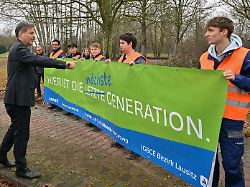Hardly any other region is so symbolic of the tour de force that the energy transition entails. But the exit from coal and the farewell to fossil fuels also represent a new beginning, said Economics Minister Habeck on his trip to the border region between Brandenburg and Saxony.
When Robert Habeck got out at the power plants of Lausitz Energie Verwaltungs GmbH (LEAG), warning vests and protest signs awaited him. “We are the next generation” says a large green banner – they have demonstratively crossed out the word “last”. The LEAG trainees are waiting for the Economics Minister on the grounds of the Schwarze Pumpe industrial plant and have a symbolic contract for him to sign.
Point 1 of the contract, which is entitled “Reliable energy policy instead of job-destroying party politics”: “The consensus of society as a whole on the coal phase-out will not be called into question!” That is expressly not the aim of the visit to the largest East German energy supplier, according to the Federal Ministry for Economic Affairs and Climate. However, the trainees do not seem convinced of this – Habeck has spoken too often of an early exit from coal by 2030. The trainees’ demand makes it clear: for many people, the exit from coal is tantamount to an insecure existence. Estimates vary, but Jens Krause from the Cottbus Chamber of Commerce assumes that around 16,000 jobs will be lost with the coal phase-out.
Behind the climate minister and the trainees, the heavy smoke from the four coal-fired power plants mixes with the clouds. Today is not about exits, but about new beginnings. Because here, on the border between Brandenburg and Saxony, the new collides with the old. Future meets past. Hardly any other region is so symbolic of the efforts that the energy transition entails. Coal has a long tradition in this region, here in the Deep East. Saying goodbye to her will be painful. But it also offers many opportunities for a new beginning, is the unequivocal message from the Economics Minister.
Pilot project hydrogen
While the charcoal piles are being started up again on one side of the Schwarze Pumpe industrial plant, a few kilometers further on the hope of the German energy transition is being worked on: Green hydrogen is to be produced in this industrial park from 2025.
The managing director of the reference plant, Ben Schüppel, uses a small model of the industrial park to show how the pilot project will work. Habeck is extremely interested. Green hydrogen is to be produced using energy from wind farms and solar systems. There will also be a hydrogen filling station at the facility. A query from Habeck: What if there is a lull in the wind? Some of the hydrogen is converted back into electricity for times when the sun isn’t shining or the wind isn’t blowing, Schüppel replies.
But it all has to be built. If all goes well, the industrial park will be operational in 2025. In order for that to happen, Habeck travels with heavy luggage: a sponsorship check for 28.5 million euros.
But this pilot project is exactly that – a first attempt to commission a hydrogen plant in Germany. There is a lack of hydrogen lines and skilled workers. Above all, however, there is a lack of renewable energies. In order to achieve the federal government’s goal of generating 80 percent of the electricity in Germany from renewable energies by 2030, 22 gigawatts of solar energy must be added annually from 2026. This corresponds to a tripling of the current expansion.
Early exit from coal
LEAG wants to contribute seven gigawatts of wind and solar energy by 2030. That would be just one gigawatt per year. According to current forecasts, a total of 14 gigawatts would be possible by 2040, according to a company spokesman for ntv.de. The company would also be willing to invest €1 billion per year in the green transformation until 2030.
However, the East German energy company is not ready to phase out coal prematurely. The LEAG boss makes that clear again: “First expansion, then exit. We stand by that,” says Thorsten Kramer in a joint press statement with Habeck. “We have a common goal: the conversion to renewable energies with simultaneous security of supply.”
The energy transition is already in the starting blocks, also at LEAG, says Eddy Menzel ntv.de. The 26-year-old completed his training as an electronics technician for industrial engineering at LEAG just a month ago. He’s not worried about his future. After all, he says, with his training he can also operate photovoltaic systems. Nevertheless: “We need more time for the changeover.”
The big question in Lusatia is whether there will be enough time. Because even if the federal government sticks to the coal phase-out in 2038, the market will most likely not do so. Experts assume that coal will disappear from the electricity mix on its own by 2030 due to high CO2 prices.
Together with his colleague, Menzel tries to get the Economics Minister to sign the symbolic contract. They make one last attempt and offer to delete the last point: “Current profits should now be invested in our future technologies and not skimmed off!” But it doesn’t help. The economy minister rejects the offer. Because contracts are at the end of a process. “We are still at the beginning here,” says the Economics Minister.
